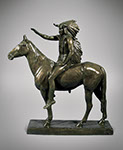
- ESTABLISHED 1976 -
Dallin, NA
Cyrus Edwin
This 1979 casting was performed by Young Fine Art Castings in Salt Lake City, Utah by sculptor Avard Fairbanks under the supervision of Brand Galleries Limited in Los Angeles and is authorized by the Museum of Fine Arts in Boston. It is made from one of their previously not cast, original models by Dallin, which the MOFA received in the estate of the artist.
Cyrus Dallin was born in Springville, Utah in 1861, the son of a covered wagon pioneer. The tribe of friendly Ute Indians that came each Spring and Fall to trade with the newly founded town of Springville was incentive to the young man to dedicate himself to Native American subjects. He befriended the Indian boys and grew to admire them and have a tremendous respect for their culture. By 1884 he was sent in Boston to study sculpture with Truman Howe Bartlett. His studies there, and at the Julien Academy in Paris further inspired him to execute his compositions relating the predicament of the American Indian. He was one of the first sculptors to recognize the plight of the American Indian and to devote his life and art to making dramatic and heroic monuments that proclaimed the Indian point of view.
He was very successful in his early years with a series known as the Indian cycle. This series was intended to show the cycle of the American Indian’s relation with the white man. It included his popular subjects, The Signal of Peace, The Medicine Man, The Protest and The Appeal to the Great Spirit. For Dallin it provided a means to utilize the preliminary studies that he made from visiting Buffalo Bill’s camp at Neuilly, France while he was studying in Paris in1888. However, it also made a statement for the artist that commanded the attention of a broad collectorship as well. His creations were later commissioned in heroic size for institutions of the towns of Salt Lake City, Boston, Washington DC, Plymouth, Massachusetts, Kansas City, Philadelphia and others.
Throughout his life he was an eloquent defender of the American Indian. His intimate knowledge of them gave his work an authenticity and a reality heretofore unknown. His personal involvement with their cause gave his statures a dramatic impact, which has retained its strength through the years. The simplicity of his sculptural style with its emphasis on the essentials rather than the decorative, gives Dallin’s statures a special appeal to the aesthetic taste of the modern world.
(1837 - 1918)
Back to Inventory



